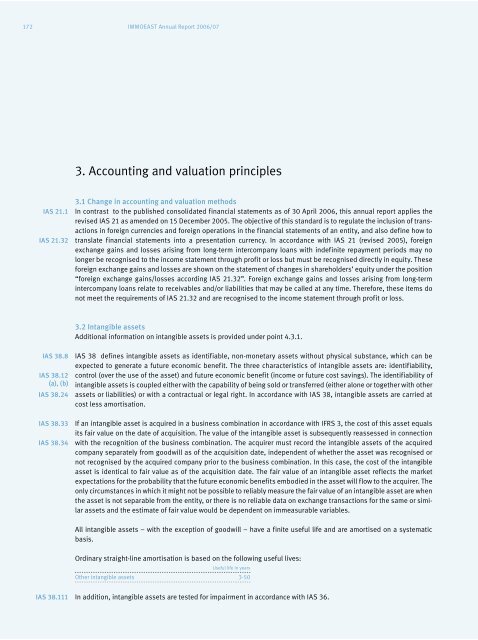IMMOEAST Annual Report 2006/07
IMMOEAST Annual Report 2006/07
IMMOEAST Annual Report 2006/07
You also want an ePaper? Increase the reach of your titles
YUMPU automatically turns print PDFs into web optimized ePapers that Google loves.
172 <strong>IMMOEAST</strong> <strong>Annual</strong> <strong>Report</strong> <strong>2006</strong>/<strong>07</strong><br />
IAS 21.1<br />
IAS 21.32<br />
IAS 38.8<br />
IAS 38.12<br />
(a), (b)<br />
IAS 38.24<br />
IAS 38.33<br />
IAS 38.34<br />
IAS 38.111<br />
3. Accounting and valuation principles<br />
3.1 Change in accounting and valuation methods<br />
In contrast to the published consolidated financial statements as of 30 April <strong>2006</strong>, this annual report applies the<br />
revised IAS 21 as amended on 15 December 2005. The objective of this standard is to regulate the inclusion of transactions<br />
in foreign currencies and foreign operations in the financial statements of an entity, and also define how to<br />
translate financial statements into a presentation currency. In accordance with IAS 21 (revised 2005), foreign<br />
exchange gains and losses arising from long-term intercompany loans with indefinite repayment periods may no<br />
longer be recognised to the income statement through profit or loss but must be recognised directly in equity. These<br />
foreign exchange gains and losses are shown on the statement of changes in shareholders’ equity under the position<br />
“foreign exchange gains/losses according IAS 21.32”. Foreign exchange gains and losses arising from long-term<br />
intercompany loans relate to receivables and/or liabilities that may be called at any time. Therefore, these items do<br />
not meet the requirements of IAS 21.32 and are recognised to the income statement through profit or loss.<br />
3.2 Intangible assets<br />
Additional information on intangible assets is provided under point 4.3.1.<br />
IAS 38 defines intangible assets as identifiable, non-monetary assets without physical substance, which can be<br />
expected to generate a future economic benefit. The three characteristics of intangible assets are: identifiability,<br />
control (over the use of the asset) and future economic benefit (income or future cost savings). The identifiability of<br />
intangible assets is coupled either with the capability of being sold or transferred (either alone or together with other<br />
assets or liabilities) or with a contractual or legal right. In accordance with IAS 38, intangible assets are carried at<br />
cost less amortisation.<br />
If an intangible asset is acquired in a business combination in accordance with IFRS 3, the cost of this asset equals<br />
its fair value on the date of acquisition. The value of the intangible asset is subsequently reassessed in connection<br />
with the recognition of the business combination. The acquirer must record the intangible assets of the acquired<br />
company separately from goodwill as of the acquisition date, independent of whether the asset was recognised or<br />
not recognised by the acquired company prior to the business combination. In this case, the cost of the intangible<br />
asset is identical to fair value as of the acquisition date. The fair value of an intangible asset reflects the market<br />
expectations for the probability that the future economic benefits embodied in the asset will flow to the acquirer. The<br />
only circumstances in which it might not be possible to reliably measure the fair value of an intangible asset are when<br />
the asset is not separable from the entity, or there is no reliable data on exchange transactions for the same or similar<br />
assets and the estimate of fair value would be dependent on immeasurable variables.<br />
All intangible assets – with the exception of goodwill – have a finite useful life and are amortised on a systematic<br />
basis.<br />
Ordinary straight-line amortisation is based on the following useful lives:<br />
Useful life in years<br />
Other intangible assets 3-50<br />
In addition, intangible assets are tested for impairment in accordance with IAS 36.


